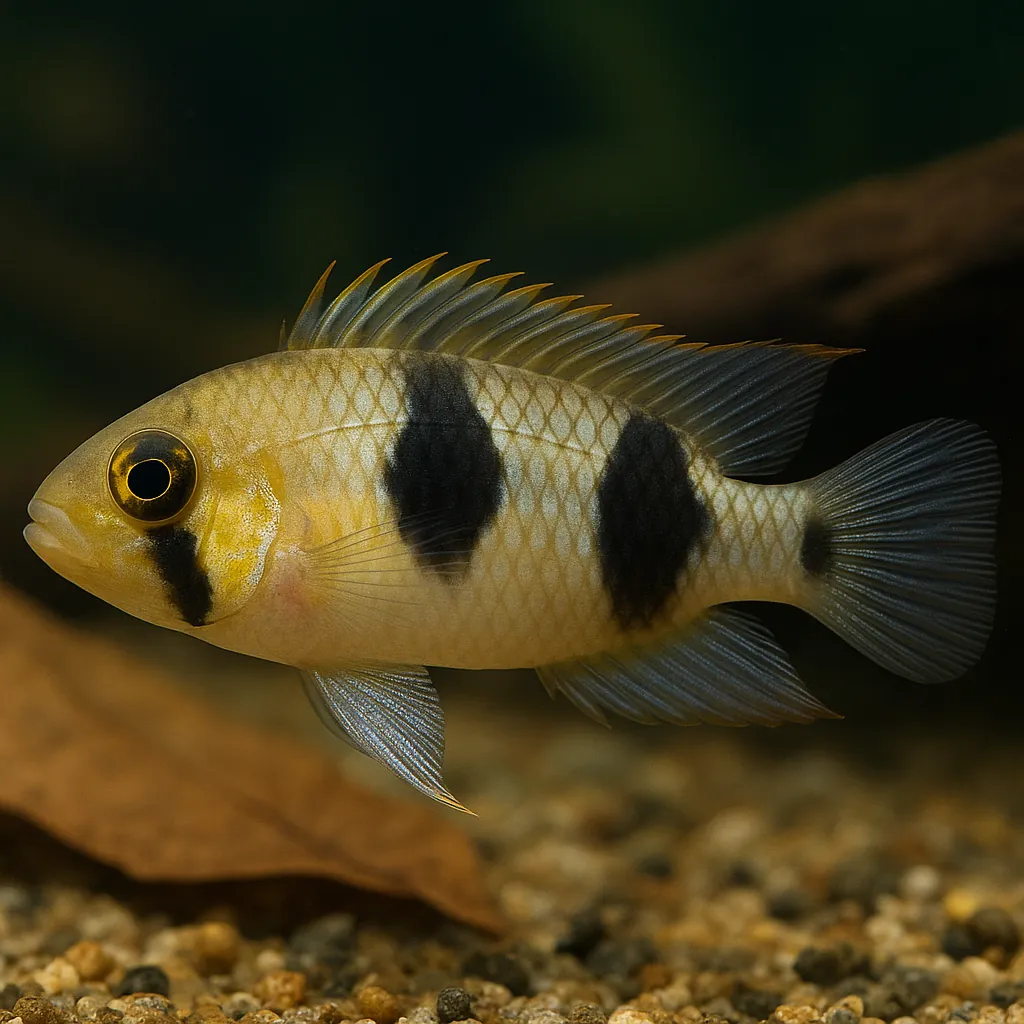
Panda dwarf cichlid
Introduction
The Panda Dwarf Cichlid (Apistogramma nijsseni) is a captivating freshwater fish native to Peru's Ucayali River drainage. Renowned for its striking coloration and manageable size, this species has become a favorite among aquarists seeking a vibrant addition to their tanks. While their beauty is undeniable, Panda Dwarf Cichlids require specific care to thrive, making them more suitable for hobbyists with some experience in fishkeeping.
What makes the Panda Dwarf Cichlid stand out in an aquarium?
Its vivid coloration, featuring a blend of blue, black, and yellow hues, combined with its dynamic behavior, adds a lively presence to any tank.
Is this species suitable for beginners?
Due to their sensitivity to water conditions and specific care requirements, they are better suited for aquarists with some experience.
Care and Environment
Providing optimal care for the Panda Dwarf Cichlid involves meticulous attention to their environment and dietary needs. A minimum tank size of 60 liters is recommended for a single pair, but a larger tank of at least 80 liters is ideal for a group, allowing for the establishment of territories and reducing potential aggression. The tank should be furnished with dense vegetation, driftwood, stones, and caves to offer ample hiding spots and mimic their natural habitat. A sandy substrate is preferred, as it allows the fish to exhibit natural behaviors like sifting.
Maintaining stable water parameters is crucial. The ideal temperature range is between 24°C and 28°C, with a pH of 5.0 to 6.5, and water hardness between 0 and 4 dGH. Regular water changes are essential to keep nitrate levels low and ensure water quality. Efficient filtration is necessary, but strong currents should be avoided to replicate the calm waters of their native environment.
In terms of diet, Panda Dwarf Cichlids are primarily carnivorous. They thrive on a varied diet that includes live or frozen foods such as brine shrimp, daphnia, and bloodworms. While some individuals may accept high-quality pellets or flakes, live foods are often preferred and can enhance their coloration and overall health.
How often should I feed my Panda Dwarf Cichlid?
It's advisable to feed them small amounts 2–3 times daily to prevent overfeeding and maintain water quality.
Can they adapt to different water parameters?
While they prefer soft, acidic water, captive-bred specimens can adapt to slightly harder conditions, but sudden changes should be avoided to prevent stress.
Origin and Habitat
Native to the Quebrada Carahuayte, a small stream in the Ucayali River drainage of southern Peru, the Panda Dwarf Cichlid inhabits blackwater environments characterized by soft, acidic waters with low mineral content. These habitats are typically shaded by dense forest canopies, resulting in dim lighting conditions. The substrate in these areas is often composed of fine sand, with abundant leaf litter and submerged roots providing ample hiding spots and breeding sites.
What are blackwater environments?
Blackwater environments are freshwater habitats with dark-colored waters due to decomposing organic matter, leading to acidic conditions and low mineral content.
How does their natural habitat influence their care in captivity?
Replicating their natural habitat by providing soft, acidic water, dim lighting, and plenty of hiding spots can help reduce stress and promote natural behaviors.
Temperament and Compatibility
Panda Dwarf Cichlids are generally peaceful but can exhibit territorial behavior, especially during breeding. Males may become aggressive towards females that are not ready to spawn, so it's advisable to keep at least two females for every male in a breeding setup. In community tanks, they can coexist with small, peaceful species such as tetras, rasboras, Corydoras catfish, and small plecos. However, it's best to avoid housing them with larger or aggressive fish that might intimidate or outcompete them.
Can they be kept with other cichlids?
It's generally recommended to avoid keeping them with other Apistogramma species to prevent territorial disputes and potential hybridization.
How can I minimize aggression in the tank?
Providing ample hiding spots, visual barriers, and sufficient space can help reduce aggression and allow each fish to establish its own territory.
Interesting Facts
The Panda Dwarf Cichlid exhibits remarkable sexual dimorphism. Males display a vibrant mix of blue and black with a checkerboard pattern, while females are predominantly bright yellow with distinctive black markings, resembling a panda's coloration. This striking difference makes them easily distinguishable and adds to their appeal among aquarists.
In their natural habitat, these cichlids are cave spawners. Females lay eggs in secluded spots and are primarily responsible for guarding the eggs and fry, showcasing strong parental care behaviors. This natural inclination can be observed in captivity by providing suitable breeding sites like caves or flowerpots.
Why are they called "Panda" Dwarf Cichlids?
The name derives from the female's bright yellow body adorned with black blotches, reminiscent of a panda's coloration.
Do they exhibit unique behaviors during breeding?
Yes, females become highly protective of their eggs and fry, often becoming more aggressive to safeguard their offspring.
Sources
All information in this article has been gathered from the following reputable sources:
Overview
Recommended Tank Size 21.1 Gallons (for a pair or small group) |
Minimum Group Size 2 |
Minimum Tank Volume 15.9 Gallons |
Maximum Adult Length 3.1 inches |
Average Adult Length 2 inches |
Shoaling (6+ required) No |
Preferred Water Type Soft, acidic freshwater |
Temperature Range (°C) 24–28 |
pH Range 5.0–6.5 |
Water Hardness (dGH) 0–4 |
Typical Lifespan (years) 5 years |